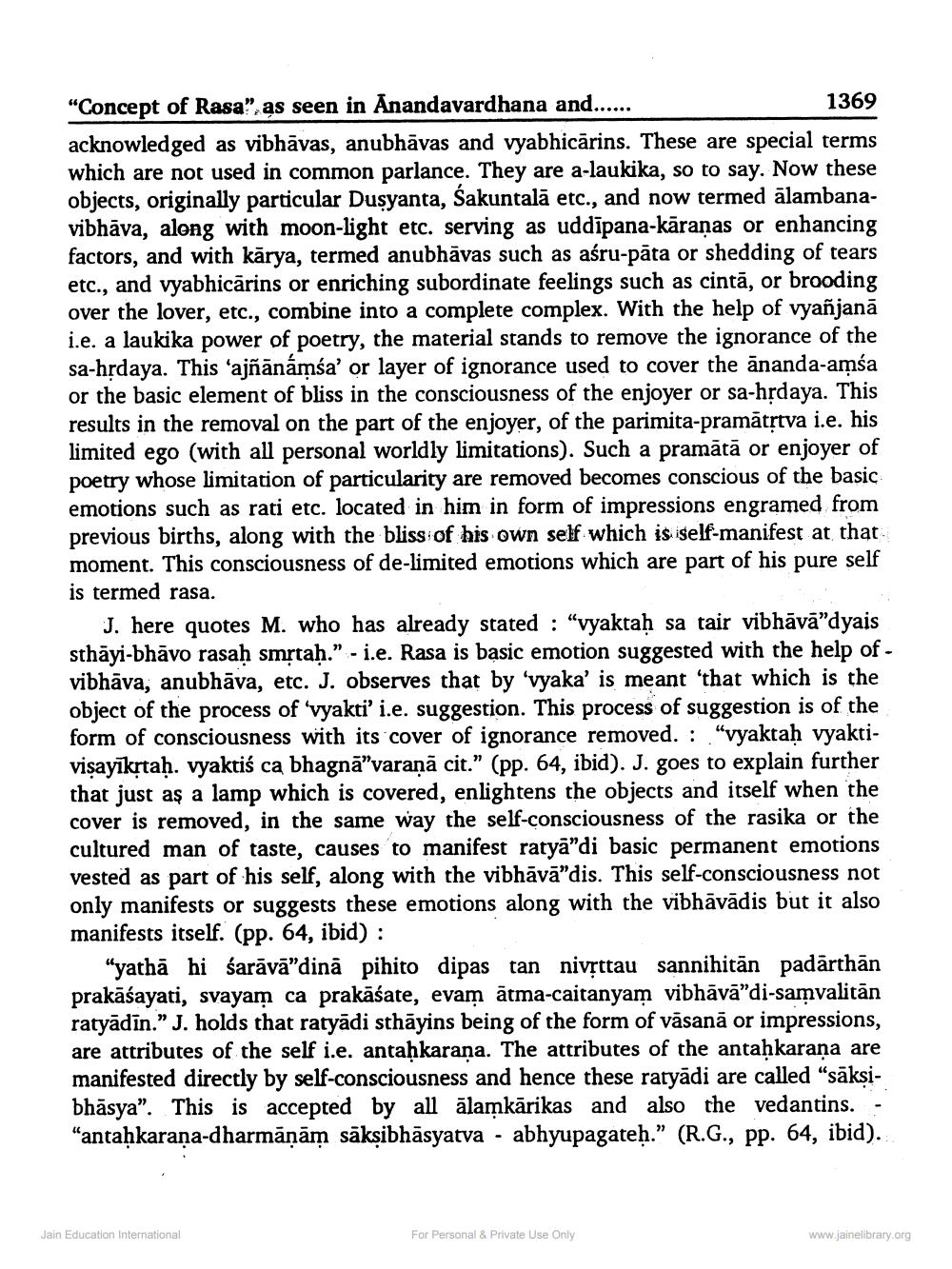________________
"Concept of Rasa”, as seen in Anandavardhana and.....
1369 acknowledged as vibhāvas, anubhāvas and vyabhicărins. These are special terms which are not used in common parlance. They are a-laukika, so to say. Now these objects, originally particular Dusyanta, Sakuntalā etc., and now termed ālambanavibhāva, along with moon-light etc. serving as uddīpana-kāranas or enhancing factors, and with kārya, termed anubhāvas such as aśru-pāta or shedding of tears etc., and vyabhicārins or enriching subordinate feelings such as cintā, or brooding over the lover, etc., combine into a complete complex. With the help of vyañjanā i.e. a laukika power of poetry, the material stands to remove the ignorance of the sa-hțdaya. This ‘ajñānámśa' or layer of ignorance used to cover the ananda-amsa or the basic element of bliss in the consciousness of the enjoyer or sa-hrdaya. This results in the removal on the part of the enjoyer, of the parimita-pramātstva i.e. his limited ego (with all personal worldly limitations). Such a pramātā or enjoyer of poetry whose limitation of particularity are removed becomes conscious of the basic emotions such as rati etc. located in him in form of impressions engramed from previous births, along with the bliss of his own self which is self-manifest at that moment. This consciousness of de-limited emotions which are part of his pure self is termed rasa.
J. here quotes M. who has already stated : "vyaktaḥ sa tair vibhāvā”dyais sthāyi-bhāvo rasaḥ smộtah.” - i.e. Rasa is basic emotion suggested with the help of - vibhāva, anubhāva, etc. J. observes that by 'vyaka' is meant 'that which is the object of the process of 'vyakti' i.e. suggestion. This process of suggestion is of the form of consciousness with its cover of ignorance removed. :"vyaktaḥ vyaktivisayīkstaḥ. vyaktiś ca bhagnā"varaņā cit.” (pp. 64, ibid). J. goes to explain further that just as a lamp which is covered, enlightens the objects and itself when the cover is removed, in the same way the self-consciousness of the rasika or the cultured man of taste, causes to manifest ratyā"di basic permanent emotions vested as part of his self, along with the vibhāvā"dis. This self-consciousness not only manifests or suggests these emotions along with the vibhāvādis but it also manifests itself. (pp. 64, ibid):
“yathā hi sarāvā”dinā pihito dipas tan nivșttau sannihitān padārthān prakāśayati, svayam ca prakāśate, evam ātma-caitanyam vibhāvā”di-samvalitān ratyādīn." J. holds that ratyādi sthāyins being of the form of vāsanā or impressions, are attributes of the self i.e. antahkarana. The attributes of the antahkarana are manifested directly by self-consciousness and hence these ratyādi are called "sāksibhāsya”. This is accepted by all ālamkārikas and also the vedantins.“antaḥkarana-dharmāņām sākṣibhāsyatva - abhyupagateh.” (R.G., pp. 64, ibid).
Jain Education International
For Personal & Private Use Only
www.jainelibrary.org




